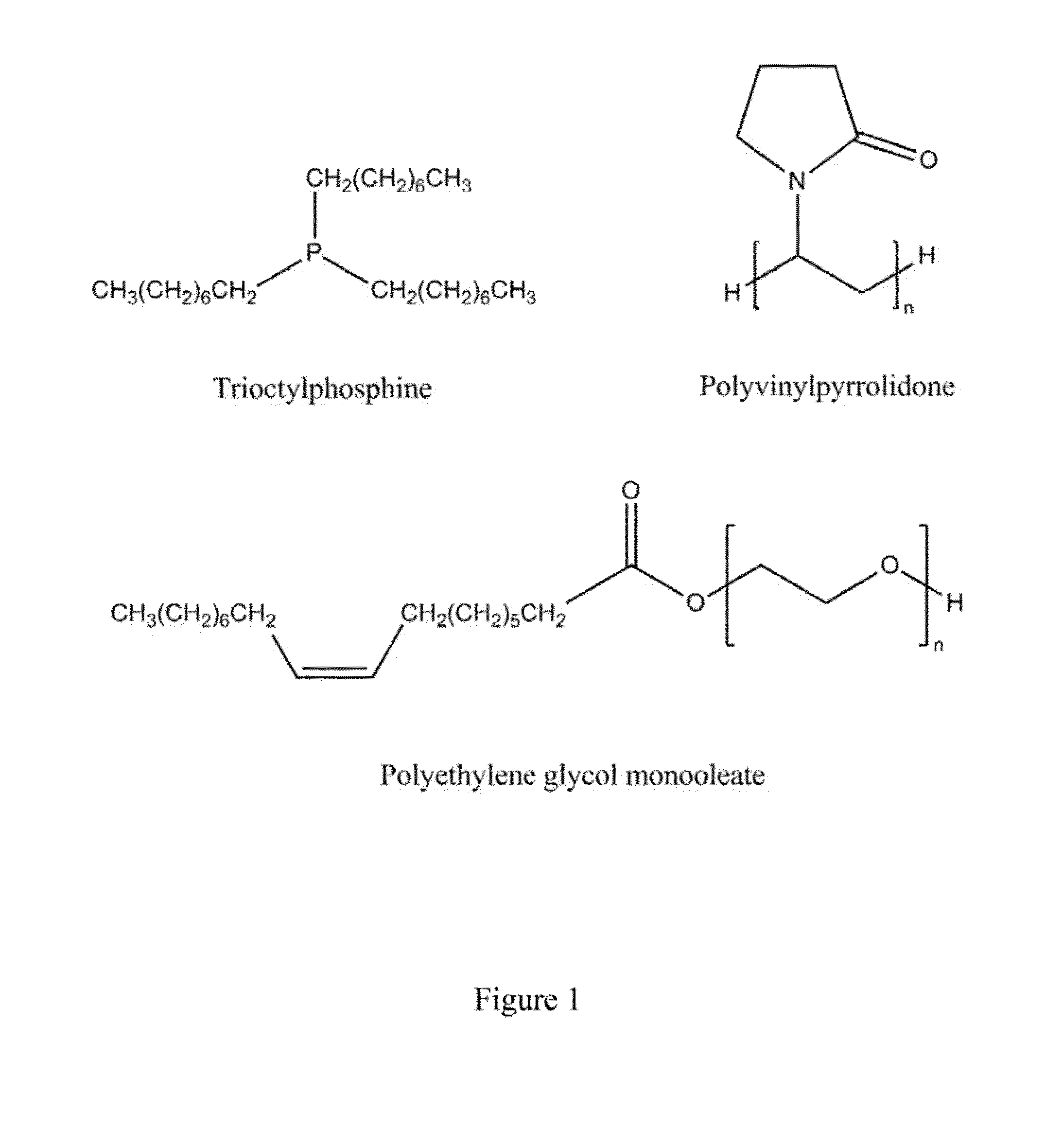Surfactant effects on efficiency enhancement of luminescent particles
a technology of surfactant and luminescent particles, which is applied in the direction of luminescent compositions, chemistry apparatuses and processes, etc., can solve the problems of significant reduction of emitted light from the light-emitting phosphor core, high reflectance loss of emitted light, etc., and achieve the effect of reducing the refractive index mismatch
- Summary
- Abstract
- Description
- Claims
- Application Information
AI Technical Summary
Benefits of technology
Problems solved by technology
Method used
Image
Examples
example 1
Hydrothermal Synthesis of NaYF4:Yb—Er Upconversion Phosphors
[0036]Stoichiometric amounts of rare earth nitrates (Sigma Aldrich, St. Louis, Mo.) were mixed with 1.5 times excess sodium fluoride in about 70 mL of water:ethanol mixture (80:20 v / v) and various additives for 30 min to synthesize NaY0.78Yb0.20Er0.02F4 particles. 2×10−4; moles which corresponds to 0.1 mL, 0.1 mL and 8 g of trioctylphosphine, polyethylene glycol monooleate (PEG monooleate, average Mn of about 460 g / mol) and polyvinylpyrrolidone (average Mn of about 40,000 g / mol), respectively from Sigma Aldrich was added to the reaction mix. This mixture was next transferred to a 125 mL. Teflon liner and heated to about 240° C. for 4 h in a Parr pressure vessel (Parr Instrument Company, Moline, Ill.). The as-synthesized particles were washed three times in deionized water by centrifuging (Beckman-Coulter Avanti J-26 XP, Fullerton, Calif.) and dried at 70° C. in air in a mechanical convection oven (Thermo Scientific Thermoly...
example 2
Powder Characterization by X-ray Diffraction
[0037]Powder x-ray diffraction (XRD) patterns were obtained with a resolution of 0.04° / step and 2 sec / step with the Siemens D500 (Bruker AXS Inc., Madison, Wis.) powder diffractometer (40 kV, 30 mA), using Cu Kα radiation (μ=1.54 Å). Powder diffraction files (PDF) from International Centre for Diffraction. Data (ICDD, Newtown Square, Pa.) PDF#97-005-1917 for hexagonal NaYF4 was used as reference.
[0038]From the XRD profiles as shown in FIG. 2, pure hexagonal-phase NaYF4:Yb—Er powders were synthesized using the hydrothermal method and different surfactants. No statistically significant difference in grain sizes were observed based on the full width at half maximum of the various diffraction peaks for the different powders. Using the Scherrer equation, the average grain size estimated for each of the different powders shown in FIG. 2 was about 41±5 nm. Since the concentration of rare earths in the host lattice has a significant effect on the ...
example 3
Powder Characterization by X-ray Photoelectron Spectroscopy
[0039]X-ray photoelectron spectroscopy (XPS) measurements were performed using XSAM 800 KRATOS apparatus with a 127 mm radius concentric hemispherical analyzer (CHA). An Al Kα radiation with a photon energy of 1486.6 eV was used as x-ray source; and photoelectrons were detected by the CHA operated in the fixed retarding ratio mode FRR5 (survey scans), and in the fixed analyzer transmission modes FAT20 or FAT40 (detail scans) with the pass energies of 20 and 40 eV, respectively, XPS quantification of the atomic fraction for each component was determined by comparing relative intensities of photoelectron peaks together with the corresponding sensitivity factors, and assuming their total intensities to be 100%. The atomic fraction was subsequently normalized to the integrated intensity of Na (2s) peaks to allow for comparisons between samples. The measurements were performed under UHV conditions with a residual pressure of abou...
PUM
 Login to View More
Login to View More Abstract
Description
Claims
Application Information
 Login to View More
Login to View More - R&D
- Intellectual Property
- Life Sciences
- Materials
- Tech Scout
- Unparalleled Data Quality
- Higher Quality Content
- 60% Fewer Hallucinations
Browse by: Latest US Patents, China's latest patents, Technical Efficacy Thesaurus, Application Domain, Technology Topic, Popular Technical Reports.
© 2025 PatSnap. All rights reserved.Legal|Privacy policy|Modern Slavery Act Transparency Statement|Sitemap|About US| Contact US: help@patsnap.com



